The only public slipway on the canal is at Boehill, near Sampford Peverell. This is very near to Junction 27 on the M5 and Tiverton Parkway station. Tiverton itself is 6.5 miles away by canal, and there is no longer a railway station in the town itself. It is a small irony that while the railway killed the canal as a commercial transport system, the canal has been returned to life as a leisure facility and wildlife habitat.

It was a very straightforward run down to Boehill along the M5. We bought a day licence for £3 and day parking for £1 from the Minnows Touring Park, a touring caravan site on the canal, although (as it turns out) not the actual slipway. We filled out the rather grand form and were duly issued with a paper licence "plate" to stick on the boat. We followed their directions to the slipway which is accessed down a narrow track. This would be a nightmare for someone towing a trailer if they ever met anyone. Fortunately, the track opens out to a very nice slipway area with plenty of room to turn round or, in our case, to unload and assemble the boat. It might not be so stress-free if the slipway was ever busy, and it will require some logistic skill for the canal to host the 2008 Trail Boat festival unless they are planning an additional slipway at the showground.
Once assembled and launched, one half of the crew set off eastwards back to the caravan site while the other returned to park the car there for a very reasonable £1 charge. We arrived at about the same time, turned the boat round, and set off westwards towards Tiverton. The promised break in the weather had not entirely materialised at this point, but the rain was losing some of its enthusiasm.
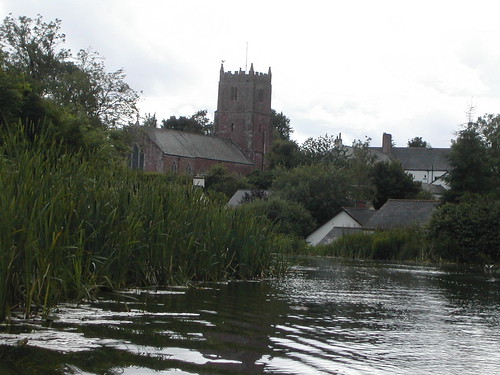
By the time we had covered the short distance to Sampford Peverall proper, the rain had stopped and there was patchy sun. And it was starting to dawn on us what a really beautiful canal this is. The water is wonderfully clear, and the banks are lush with vegetation.
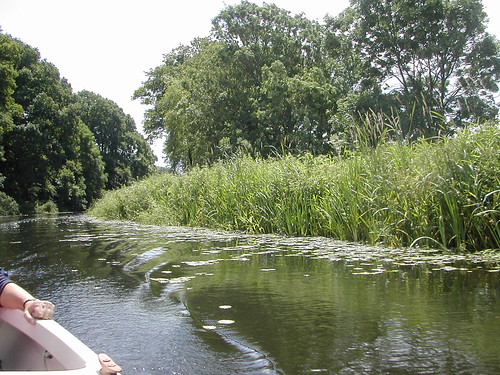
The many fishermen we saw looked like they expected to catch something. There were kingfishers, and water lillies, and ... duck weed.

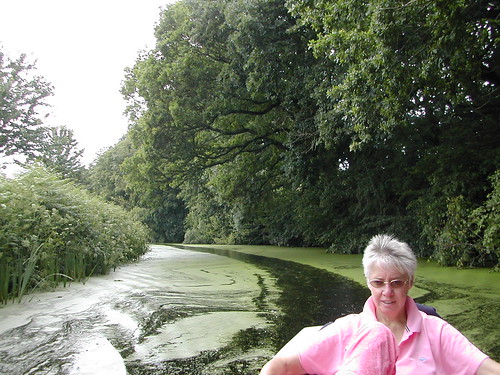
Duckweed has a bad reputation among boaters because you often find it on stagnant water, and such water tends to be impassable. But that's not because of the duckweed, which as far as we could tell was simply floating on the surface. As you can see, Winsome cut through it with no apparent effort. I'm guessing it isn't the duckweed but the fact that it hides underwater debris that accumulates on the relatively static water duckweed tends to colonise. In fact, there were no underwater obstructions we encountered, and duckweed is a sign of healthy water - which the Grand Western Canal certainly is.
About halfway between Sampford and Tiverton there is a canalside car park with a lifting pedestrian bridge. We think Winsome could be launched over the bank here, although the safety boulders planted by the CC to stop cars running into the canal would need to be avoided. The lift bridge is a recent construction on an older abutment, and is very finely balanced. You need to open its combination padlock (you get the number with your licence) and then reach up and pull down on the counterweight bar to lift the bridge onto a catch which holds it in the vertical position. When you release the catch, it drops down smoothly but alas not quite completely. This means you have to walk onto the partially open bridge to complete its descent, which is quite noisy - but fun!
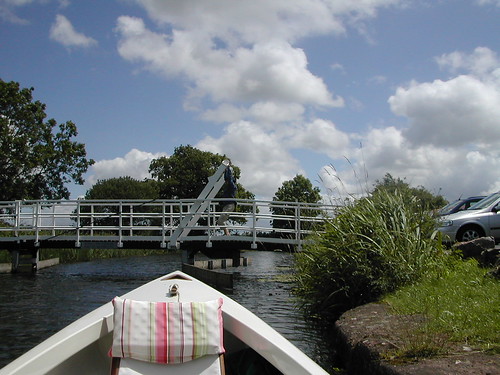

We made good progress - our usual 4.1mph on the GPS - along the canal and under its many beautiful bridges. The bridges on the Mon&Brec are somewhat "rustic" by comparison, and I wouldn't mind betting that having so many bridges built with dressed red sandstone must have had some impact on the budget - that, and the late decision by the builders to avoid locks on this section of the canal. This makes it longer than it might have been to follow the contour where feasible, but incorporating costly cuts and embankments where it isn't. That, and the need to divert around the the rather fine house of the Bishoip of Exeter of the time to keep the canal 100 yards away from his doorstep. In the early 1800's, having a canal on your doorstep probably didn't do a lot for property prices. In 2007, of course, everyone wants to be close to the water, provided, of course, that doesn't mean being regularly inundated.

So in about 2 hours we arrived at the canal terminus at Tiverton, which is some way from the town centre (actually at the top of a hill). It's not clear the canal builders expected this arm of the canal to go much further in this direction. At the terminus there is a visitor centre, a floating canal shop (closed when we got there) and a ranger station on the other side of the canal accessed by an intriguing self-operated ferry.

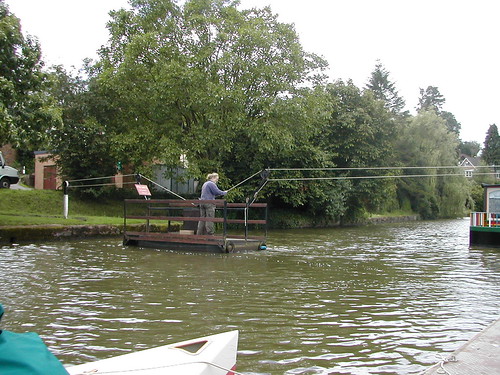
There was also a horse-drawn trip boat, with horse waiting to go. Below the canal at the terminus is a car park and a delightful thatched tea room offering exactly the kind of "light lunch" we were up for after our morning cruise. Not even an unconvincing rain shower could spoil this.
After lunch we returned to the basin to discover that the horse-drawn boat had gone. Hoping we would have no trouble passing her, we set off ourselves. We were surprised to find that it took about a mile to catch the trip boat, and when we passed her the horseman said they reckoned to cover about 2.5 miles in an hour. We would have been gaining on her, therefore, at about 1.5 miles an hour.
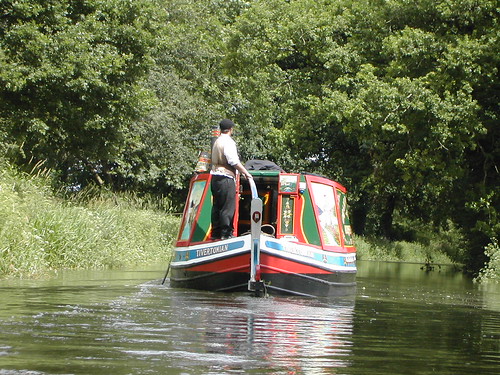

We stopped on the way back to examine some of the many water-lily colonies. We had learned from the guide book that, when the canal was under threat in the early 1960's, there was a water-lily business harvesting these delightful plants for wreaths!
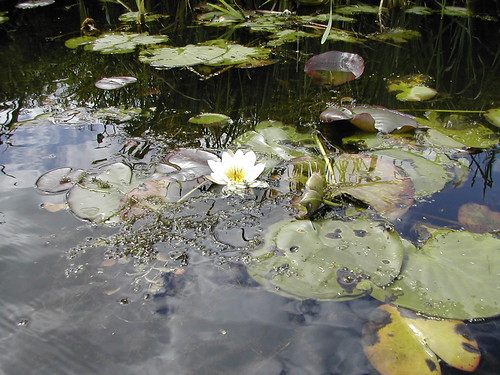
We arrived back at Boehill with enough time to spare to explore the upper reaches. The ranger had warned us that the vegetation in the eastern half of the canal might be more obstructive, but what prompted us to turn back was a family of swans with cygnets. We had already made the mistake of splitting a swan family, and this does not go down well. In any case, we'd done our 15 miles for the day and needed to recover the car and get the boat out. This was done with consummate method and skill, and we were on our way in 20 minutes - just in time to join a 20 mile traffic jam on the M5.
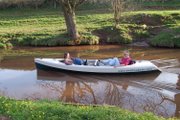
No comments:
Post a Comment